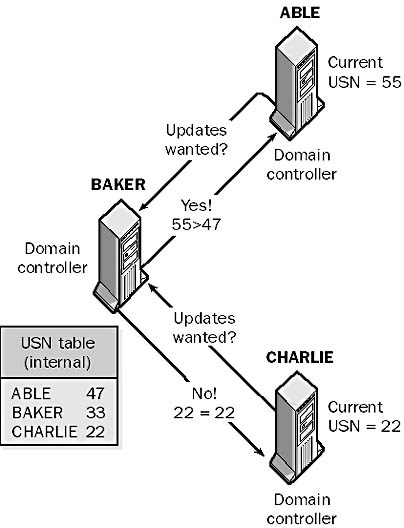How Update Sequence Number (USN) Works--更新序列号如何工作
2015-10-29 11:54
555 查看
update sequence number (USN)
Definition of update sequence number (USN) in The Network Encyclopedia.update sequence number (USN)
Update Sequence Number, or USN, is a type of identifier for controlling directory replication in Microsoft BackOffice products such as Microsoft Exchange Server and in Microsoft Windows 2000.How Update Sequence Number (USN) Works
As an example, we will consider how update sequence numbers (USNs) are used in directory replication between Windows 2000 domain controllers. When an object is changed in Active Directory, that change must be replicated to all other domain controllers. To do this, Active Directory assigns a USN to each changed object, incrementing the values with time. Each domain controller uses a table to keep track of its own current USN and the highest USN it has received from each of the other domain controllers on the network.
举例来说,我们将思考在Windows 2000域控制器之间,在目录复制中如何使用USN。当在活动目录中更改一个对象,那么更改必须被复制到所有其他域控制器。为此,活动目录分配给每一个更改的对象分配一个USN,随着时间的推移值会递增。每一个域控制器使用一张表格持续追踪它当前拥有的USN,和接收来自网络上每一个其他域控制器的最高USN.

Graphic U-4. Update sequence number (USN).
For example, if a domain controller called ABLE notifies a domain controller called BAKER of the updates it has for Active Directory, ABLE sends its own current USN number to BAKER, which compares the USN with the USN it recorded for ABLE in its internal table after the last directory update it received from ABLE. If the received USN is higher than the recorded USN, BAKER requests that ABLE send its updates for the directory. If the received USN is equal to or lower than the recorded one, BAKER knows that it has an up-to-date copy of ABLE’s directory and does not request any updates.
例如,假如一个叫做ABLE的域控制通知一个叫做BAKER的域控制器,它已经对活动目录进行了更新,ABLE发送它当前拥有的USN号给BAKER, BAKER比较此USN和在它内部表格中为ABLE记录的USN,如果此USN比记录的USN高,那么BAKER请求ABLE发送它对目录的更新。如果接收的UNS等于或者低于记录的更新,那么BAKER知道它拥有ABLE目录副本的最新更新,且不请任何更新。
NOTE
USNs are more accurate than time stamps in controlling replication between domain controllers because time stamps depend on the clocks of domain controllers being exactly synchronized. However, time stamps are also employed if a tie-breaking mechanism is required for replication purposes. USNs also speed the recovery of Active Directory if a domain controller experiences a failure.
相关文章推荐
- Serv_U 安全设置以后出现530 Not logged in, home directory does not exist的解决方法
- 使用 Iisftp.vbs 设置Active Directory 用户隔离
- PHP Directory 函数的详解
- IIS FTP 出现 530 User cannot log in, home Directory Inaccessible 错误处理方法
- Linux执行.sh文件时提示No such file or directory该怎么办(三种解决办法)
- bash: /usr/bin/autocrorder: /usr/bin/python^M: bad interpreter: No such file or directory
- CodeIgniter错误mysql_connect(): No such file or directory解决方法
- WIN2008 R2 Active Directory 之二 部署企业中Windows Server 2008 R2额外域控制器
- Microsoft Active Directory 常用文档速查指南, 不定期更新
- upgrade your Active Directory from Windows 2003 to Server 2008
- How to force replication of Domain Controllers
- How do I change the schedule for replication between two domain controllers in a site?
- How To Use Repadmin for Active Directory Troubleshooting
- 组策略三部曲之二:Understanding Which GPOs to Apply
- 将Active Directory组成员复制到新组
- 如何处理日志文件丢失
- Windows Server 2016-部署第一台域控制器
- UI控件strong与weak
- 使用createSQLQuery直接封装成自定义对象
